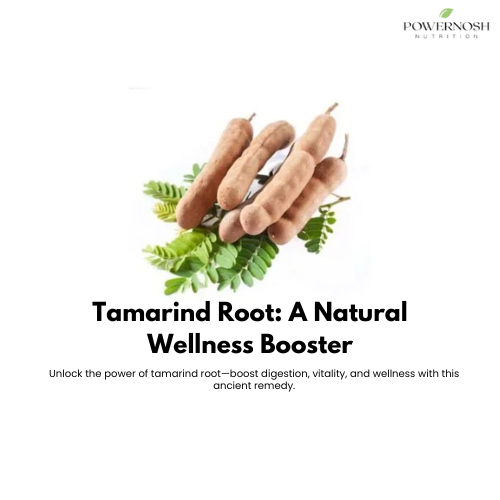
The Ultimate Guide to Tamarind Root: Benefits, Uses & Wellness Insights
Share
Tamarind root, extracted from the tamarind tree (Tamarindus indica), is a lesser-known yet potent component of traditional medicine and culinary practices across various cultures. With its origins in tropical regions of Africa and Asia, tamarind root has been revered for centuries for its medicinal properties and culinary versatility. In recent years, it has garnered attention for its potential benefits in both men and women's wellness, particularly in the realms of sexual health and overall well-being.
Nutritional Composition of Tamarind Root
Tamarind root boasts a rich nutritional profile, offering a variety of essential vitamins, minerals, and antioxidants. It is a good source of dietary fiber, which aids in digestion and promotes gut health. Additionally, tamarind root contains significant amounts of vitamin C, an antioxidant that supports immune function and collagen production. Other nutrients found in tamarind root include iron, potassium, magnesium, and B vitamins, all of which play vital roles in maintaining overall health and vitality.
Health Benefits of Tamarind Root
Tamarind Root and Digestive Health: One of the most well-known benefits of tamarind root is its positive impact on digestive health. The high fiber content in tamarind root helps regulate bowel movements and prevent constipation. Additionally, tamarind root contains natural laxative properties, making it effective in relieving digestive discomfort and promoting regularity.
Antioxidant Properties:*Tamarind root is rich in antioxidants, including vitamin C and flavonoids, which help combat oxidative stress and reduce inflammation in the body. By neutralizing harmful free radicals, tamarind root protects cells from damage and lowers the risk of chronic diseases such as heart disease, diabetes, and cancer.
Tamarind Root and Sexual Wellness:In traditional medicine systems, tamarind root has been used to enhance libido and sexual performance in both men and women. While scientific research on this topic is limited, anecdotal evidence suggests that tamarind root may have aphrodisiac properties and could potentially support sexual health and vitality.
Culinary Uses of Tamarind Root
Tamarind root is a versatile ingredient in culinary applications, adding a unique flavor and depth to a wide range of dishes. In traditional cuisines, tamarind root is often used to impart a tangy and slightly sour taste to soups, stews, sauces, and marinades. It is also commonly used in savory dishes such as curries, stir-fries, and chutneys.
In addition to its culinary uses, tamarind root is a popular ingredient in beverages and desserts. Tamarind root juice, made by soaking tamarind root in water and straining the liquid, is a refreshing and thirst-quenching drink enjoyed in many tropical regions. Tamarind root is also used to make candies, jams, and sweets, adding a unique flavor twist to confectionery products.
Tamarind Root in Traditional Medicine
In traditional medicine systems such as Ayurveda and traditional Chinese medicine, tamarind root has been valued for its medicinal properties for centuries. It is believed to have cooling and detoxifying effects on the body, making it useful for treating various ailments such as fever, inflammation, and digestive disorders. Tamarind root is often included in herbal remedies and tonics designed to promote overall health and well-being.
Growing and Harvesting Tamarind Root
Tamarind trees are typically grown in tropical and subtropical regions with warm climates and well-drained soil. The roots of the tamarind tree are harvested by digging up the root system, which consists of large tuberous roots that store water and nutrients for the tree. Tamarind root can be harvested year-round, although it is often done during the dry season when the roots are more accessible.
Sustainability and Environmental Impact
The cultivation of tamarind trees for their roots is generally considered sustainable, as they are hardy and resilient plants that require minimal water and maintenance. Tamarind trees also provide additional environmental benefits, such as shade, erosion control, and habitat for wildlife. However, as with any agricultural crop, it is essential to practice responsible farming techniques to minimize environmental impact and preserve natural resources.
Tamarind Root in Men and Women's Wellness
Tamarind root has gained popularity in recent years as a natural remedy for promoting men and women's wellness. While scientific research on its specific health benefits is limited, anecdotal evidence and traditional wisdom suggest that tamarind root may have a positive impact on sexual health, digestive function, and overall vitality. Incorporating tamarind root into a balanced diet and lifestyle may help support optimal health and well-being for both men and women.
Conclusion
In conclusion, tamarind root is a versatile and nutritious ingredient with a wide range of potential health benefits. From its digestive benefits and antioxidant properties to its traditional uses in promoting sexual wellness, tamarind root offers a holistic approach to supporting men and women's health. By incorporating tamarind root into their diet and lifestyle, individuals can harness the power of this ancient remedy to promote vitality and well-being for generations to come.
Source Link
https://www.healthline.com/nutrition/tamarind

